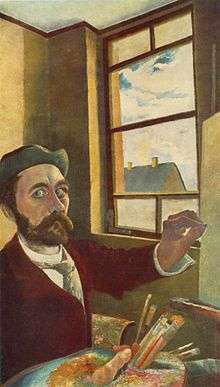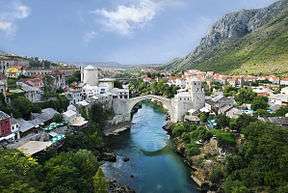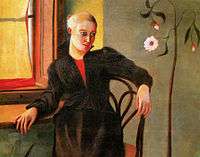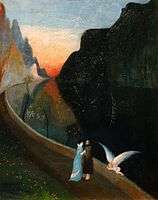Tivadar Csontváry Kosztka
| Tivadar Csontváry Kosztka | |
|---|---|
 Self-portrait (around 1900) | |
| Born |
July 5, 1853 Kisszeben, Sáros County, Kingdom of Hungary (now Sabinov, Slovakia) |
| Died |
June 20, 1919 (aged 65) Budapest, Hungary |
| Nationality | Hungarian |
| Known for | Painter |
| Movement | Post-Impressionism, expressionism |
Tivadar Csontváry Kosztka (Hungarian pronunciation: [ˈtivɒdɒr ˈt͡ʃontvaːri ˈkostkɒ]; July 5, 1853 – June 20, 1919) was a Hungarian painter who was part of the avant-garde movement of the early twentieth century.[1] Working mostly in Budapest, he was one of the first Hungarian painters to become known in Europe. On 15 December 2006 the Kieselbach Gallery in Budapest sold an auction the most expensive Csontváry painting so far. The Rendezvous (1902) ("Meeting of the lovers") was bought by an anonymous client for more than one million EUR.
His works are held by the Hungarian National Gallery in Budapest and the Csontváry Museum in Pécs, among other institutions and private collectors.
Life
Csontváry was born on 5 July 1853 in Kisszeben, Sáros County, Kingdom of Hungary (today Sabinov, Slovakia), and died 20 June 1919 in Budapest. His Kosztka -ancestors on his father´s side were Poles who settled in Hungary.[2] Although Csontváry was obsessed with his Magyar roots, he grew up speaking Slovak mixed with German.[3] He was a pharmacist until his twenties.[4]
On the hot sunny afternoon of 13 October 1880, when he was 27 years old, he had a mystic vision. He heard a voice saying, "You are going to be the greatest painter of the world, greater than Raphael."[5] He took journeys around Europe, visited the galleries of the Vatican, and returned to Hungary to earn money for his journeys by working as an apothecary. From 1890, he traveled around the world. He visited Paris, the Mediterraneum (Dalmatia, Italy, Greece), North Africa and the Middle East (Lebanon, Palestine, Egypt, Syria) and painted pictures. Often his pictures are very large, several metres (yards) wide and height is not unusual.
 Bridge from Mostar 2007 |
.jpg) Tivadar Csontváry Kosztka, painting 1903 |
|---|---|
He painted his major works between 1903 and 1909. He had some exhibitions in Paris (1907) and Western Europe. Most of the critics in Western Europe recognized his abilities, art and congeniality, but in the Kingdom of Hungary during his life, he was considered to be an eccentric crank for several reasons, e. g. for his vegetarianism, anti-alcoholism, anti-smoking, pacifism, and his cloudy, prophetic writings and pamphlets about his life (Curriculum), genius (The Authority, The Genius) and religious philosophy (The Positivum). Some of his biographists considered this as a latent, but increasingly disruptive schizophrenia.[6] Although he was later acclaimed, during his lifetime Csontváry found little understanding for his visionary, expressionistic style. A loner by nature, his “failure” impaired his creative power.
- Early works.
 Woman sitting in the window.
Woman sitting in the window..jpg) Deer.
Deer..jpg) Bird of Prey.
Bird of Prey..jpg) Tennis party.
Tennis party.
He painted more than one hundred pictures, the most famous and emblematic of which is probably The Lonely Cedar (Magányos cédrus) . His art connects with post-impressionism and expressionism, but he was an autodidact and cannot be classified into one style. He identified as a "sunway"-painter, a term which he created.
.jpg) Pilgrimage to the Cedars in Lebanon, 1907, Hungarian National Gallery, Budapest
Pilgrimage to the Cedars in Lebanon, 1907, Hungarian National Gallery, Budapest.jpg) The Lonely Cedar, 1907, Csontváry Museum, Pécs
The Lonely Cedar, 1907, Csontváry Museum, Pécs.jpg) The praying Prophet (The Young Man from Nain), 1903.
The praying Prophet (The Young Man from Nain), 1903..jpg) The Wailing Wall in Jerusalem, 1904
The Wailing Wall in Jerusalem, 1904
Legacy

- The Csontváry Museum in Pécs, Hungary, was founded in his honor and holds many of his works.
A quote
- "I, Tivadar Kosztka, who gave up his prime of youth for the rebirth of the world, accepting the call of the invisible Spirit, had a regular civil job, comfort, wealth then (...) Going to Paris in 1907 I oppositely stood alone in front of millions with only the result of the divine providence, and I beat the vanity of the world hollow, but I haven't killed 10 million people, only sobered them, I haven't made commercials from things, because I didn't care for the pedlar's press; I retired from the world instead, going to the top of the Lebanons, and I painted cedars."
- T., Cs. K.: The Positivum.
Works
 Rendez-vous of Lovers, c. 1902
Rendez-vous of Lovers, c. 1902.jpg)
.jpg) Old Fisherman,
Old Fisherman,
.jpg) People passing a bridge, 1901 .
People passing a bridge, 1901 ..jpg) Castellamare di stabia, 1902.
Castellamare di stabia, 1902. Waterfall at Schaffhausen 1903
Waterfall at Schaffhausen 1903 The riders at the sea, 1909
The riders at the sea, 1909 Maria's well in Nazareth
Maria's well in Nazareth.jpg) The Mount of Olives in Jerusalem.
The Mount of Olives in Jerusalem..jpg) Panorama of Selmecbánya.
Panorama of Selmecbánya..jpg) Waterfall at Jajce.
Waterfall at Jajce.
References
- ↑ Mansbach & V. West 1991, p. 101
- ↑ Valentiner, Wilhelm Reinhold (1965). The Art quarterly. 28. Detroit Institute of Arts. p. 247.
Tivadar Kosztka — he was a descendant of old Polish aristocracy who settled in Hungary
- ↑ The Hungarian quarterly. MTI. 1997. p. 40. Retrieved 20 September 2011.
- ↑ Bäckström, Per; Hjartarson, Benedikt (2014). Decentring the Avant-Garde. Rodopi. p. 72. ISBN 978-90-420-3788-5.
- ↑ Ustasi, Macar (2010). Csontváry. Pera Müzesi. p. 86. ISBN 978-97-591-2379-6.
- ↑ "Csontváry Kosztka Tivadar munkássága a pszichobiográfia tükrében + FOTÓK". Szeged Ma - tények és vélemények. Retrieved 2016-05-24.
Sources
- Mansbach, Steven A.; V. West, Richard (1991). Standing in the tempest: painters of the Hungarian avant-garde, 1908-1930. Santa Barbara Museum of Art. ISBN 978-0-262-13274-9.
External links
| Wikimedia Commons has media related to Csontváry Kosztka Tivadar. |
| Wikiquote has quotations related to: Tivadar Csontváry Kosztka |
- An extremely high-res photo of painting Ruins of Greek Theatre at Taormina (courtesy of Hungarian National Gallery)
- Csontváry Museum, Pécs (after first switching to English)
- Fine Arts in Hungary
- Short biography
- Csontváry (1980) on IMDb
- Csontvary on the Oceanbidge
- Csontvary in Encyclopedia - Britannica Online Encyclopedia
- Galery of Tatras
- His connection with Slovakia nr. 1
- His connection with Slovakia nr. 2
- Csontváry Geniusz exhibition in Budapest, 2015